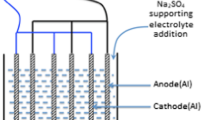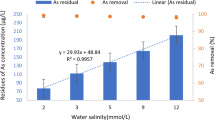Abstract
Purpose
Arsenic, a toxic metalloid in drinking water, has become a major threat for human beings and other organisms. In the present work, attempts have been made to remove arsenate from the synthetic as well as natural water of Ballia district, India by electrocoagulation method. Efforts have also been made to optimize the various parameters such as initial arsenate concentration, pH, applied voltage, processing time, and working temperature.
Method
Electrocoagulation is a fast, inexpensive, selective, accurate, reproducible, and eco-friendly method for arsenate removal from groundwater. The present paper describes an electrocoagulation method for arsenate removal from groundwater using iron and zinc as anode and cathode, respectively.
Results
The maximum removal of arsenate was 98.8% at 2.0 mg L−1, 7.0, 3.0 V, 10.0 min, and 30°C as arsenate concentration, pH, applied voltage, processing time, and working temperature, respectively. Relative standard deviation, coefficient of determination (r 2), and confidence limits were varied from 1.50% to 1.59%, 0.9996% to 0.9998%, and 96.0% to 99.0%, respectively. The treated water was clear, colorless, and odorless without any secondary contamination. The developed and validated method was applied for arsenate removal of two samples of groundwater of Ballia district, U.P., India, having 0.563 to 0.805 mg L−1, arsenate concentrations.
Conclusions
The reported method is capable for the removal of arsenate completely (100% removal) from groundwater of Ballia district. There was no change in the groundwater quality after the removal of arsenate. The treated water was safe for drinking, bathing, and recreation purposes. Therefore, this method may be the choice of arsenate removal from natural groundwater.







Similar content being viewed by others
References
Ali I, Gupta VK (2006) Advances in water treatment by adsorption technology. Nat Protocol 1:2661–2667
Ali I, Khan TA, Asim M (2011) Removal of arsenic from water by electrocoagulation and electrodialysis techniques. Sepn & Purif Rev 40:25–42
Balasubramanian N, Kojima T, Basha CA, Srinivasakannan C (2009) Removal of arsenic from aqueous solution using electrocoagulation. J Hazard Mater 167:966–969
Balasubramanian N, Madhavan K (2001) Arsenic removal from industrial effluent through electrocoagulation. Chem Eng Technol 24:519–528
Bao L, Shi H (2010) Potential molecular mechanisms for combined toxicity of arsenic and alcohol. J Inorg Biochem 104:1229–1233
Baskan MB, Pala A (2010) A statistical experiment design approach for arsenic removal by coagulation process using aluminum sulfate. Desalination 254:42–48
Brammer H, Ravenscroft P (2009) Arsenic in groundwater: a threat to sustainable agriculture in South and South-east Asia. Environ Int 35:647–654
Cao X, Ma L, Shiralipour A, Harris W (2010) Biomass reduction and arsenic transformation during composting of arsenic-rich hyper accumulator Pteris vittata L. Environ Sci Pollut Res 17:586–594
Chen G (2004) Electrochemical technologies in wastewater treatment. Sep & Purif Technol 38:11–41
Clesceri US, Greenberg AE, Trussell RR (1981) Standard methods for the examination of water and waste water. American Public Health Association, Washington
Deniel R, Himabindu V, Prabhakararao AVS, Anjayneyulu Y (2008) Removal of arsenic from waste water using electrocoagulation. J Environ Sci & Engg 50:283–288
Dolo AL, Goel S (2010) Effect of electrode combinations, pH and current density on arsenic removal from drinking water using electrocoagulation. IE(I) J-EN 90:21–25
Garcıa-Lara AM, Montero-Ocampo C, Martınez-Villafane F (2009) An empirical model for treatment of arsenic contaminated underground water by electrocoagulation process employing a bipolar cell configuration with continuous flow. Water Sci & Technol 60:2153–2160
Ghimire KN, Inoue K, Yamaguchi H, Makino K, Tohru M (2003) Adsorptive separation of arsenate and arsenite anions from aqueous medium by using orange waste. Water Res 37:4945–4953
Gomes JA, Rahman MS, Das K, Varma S, Cocke DL (2010) A comparative electrochemical study on arsenic removal using iron, aluminum, and copper electrodes. ECS Trans 25:59–68
Gomes JAG, Daida P, Kesmez M, Weir M, Moreno H, Parga JR, Irwin G, McWhinney H, Grady T, Peterson E, Cocke DL (2007) Arsenic removal by electro coagulation using combined Al-Fe electrode systems and characterization of product. J Hazard Mater 139:220–231
Gupta VK, Ali I (2004) Removal of lead and chromium from wastewater using bagasse fly ash—a sugar industry waste. J Colloid & Interface Sci 271:321–328
Gupta VK, Ali I (2008) Removal of endosulfan and methoxychlor from water on carbon slurry. Environ Sci & Technol 42:766–770
Gupta VK, Carrott PJM, Ribeiro Carrott MML, Suhas (2009) Low-cost adsorbents: growing approach to wastewater treatment. Crit Rev Environ Sci Technol 39:783–842
Gupta VK, Gupta M, Sharma S (2001) Process development for the removal of lead and chromium from aqueous solutions using red mud-an aluminum industry waste. Water Res 35:1125–1134
Gupta VK, Rastogi A (2008a) Biosorption of lead(II) from aqueous solutions by non-living algal biomass Oedogonium sp. and Nostoc sp.—a comparative study. Colloids Surf B 64:170–178
Gupta VK, Rastogi A, Dwivedi MK, Mohan D (1997) Process development for the removal of zinc and cadmium from wastewater using slag—a blast-furnace waste material. Sep Sci Technol 32:2883–2912
Gupta VK, Rastogi A, Nayak A (2010) Adsorption studies on the removal of hexavalent chromium from aqueous solution using a low cost fertilizer industry waste material. J Colloid & Interface Sci 342:135–141
Gupta VK, Rastogi A (2008b) Sorption and desorption studies of chromium(VI) from nonviable cyanobacterium Nostoc muscorum biomass. J Hazard Mat 154:347–354
Gupta VK, Saini VK, Jain N (2005) Adsorption of As (III) from aqueous solutions by iron oxide-coated sand. J Colloid Interface Sci 288:55–60
Gupta VK, Sharma S (2003) Removal of zinc from aqueous solutions using bagasse fly ash—a low cost adsorbent. Ind & Eng Chem Res 42:6619–6624
Hu C, Liu H, Chen G, Qu J (2011) Effect of aluminum speciation on arsenic removal during coagulation process. Sep & Purif Technol. doi:10.1016/j.seppur.2011.10.017
Jain CK, Ali I (2000) Arsenic: occurrence, toxicity and speciation techniques. Wat Res 34:4304–4312
Jay JA, Blute NK, Hemond HF, Durant JL (2004) Arsenic-sulfides confound anion exchange resin speciation of aqueous arsenic. Water Res 38:1155–1158
Kim J, Benjamin MM (2004) Modeling a novel ion exchange process for arsenic and nitrate removal. Water Res 38:2053–2062
Kumar PR, Chaudhari S, Khilar KC, Mahajan SP (2004) Removal of arsenic from groundwater by electrocoagulation. Chemosphere 55:1245–1252
Lakshmanan D, Clifford DA, Samanta G (2010) Comparative study of arsenic removal by iron using electrocoagulation and chemical coagulation. Wat Res 44:5641–5652
Maldonado-Reyes A, Montero-Ocampo C, Solorza-Feria O (2007) Remediation of drinking water contaminated with arsenic by electro-removal process using different metal electrodes. Environ Monit 9:1241–1247
Miller JC, Miller JN (1984) Statistics for analytical chemistry. Wiley, New York
Nalimov VV (1963) The application of mathematical statistics to chemical analysis. Pergamon Press, Oxford
Oehmen A, Valerio R, Llanos J, Fradinho J, Serra S, Reis MAM, Crespo JG, Velizarov S (2011) Arsenic removal from drinking water through a hybrid ion exchange membrane–coagulation process. Sep & Purif Tech 83:137–143
Pallier V, Feuillade-Cathalifaud G, Serpaud B, Bollinger JC (2010) Effect of organic matter on arsenic removal during coagulation/flocculation treatment. J Colloid & Interface Sci 342:26–32
Pan Y, Chiou CT, Lin T (2010) Adsorption of arsenic (V) by iron-oxide-coated diatomite (IOCD). Environ Sci Pollut Res 17:1401–1410
Peacock CL, Sherman DM (2004) Copper (II) sorption onto goethite, hematite and lepidocrocite: a surface complexation model based on ab initio molecular geometries and EXAFS spectroscopy. Geochim Cosmochim Acta 68:2623–2637
Seidel A, Waypa JJ, Elimelech M (2001) Role of charge (Donnan) exclusion in removal of arsenic from water by a negatively charged porous nano-filtration membrane. Environ Eng Sci 18:105–113
Shipley HJ, Yean S, Kan AT, Tomson MB (2010) A sorption kinetics model for arsenic adsorption to magnetite nanoparticles. Environ Sci Pollut Res 17:1053–1062
Thella K, Verma B, Srivastava VC, Srivastava KK (2008) Electrocoagulation study for the removal of arsenic and chromium from aqueous solution. J Environ Sci & Health Part A 43:554–562
Van Hege K, Verhaege M, Verstraete W (2004) Electro-oxidative abatement of low-salinity reverse osmosis membrane concentrate. Water Re 38:1550–1558
Wan W, Pepping TJ, Banerji T, Chaudhari S, Giammar DE (2011) Effects of water chemistry on arsenic removal from drinking water by electrocoagulation. Wat Res 45:384–392
Zhao X, Zhang B, Liu H, Qu J (2010) Removal of arsenite by simultaneous electro-oxidation and electro-coagulation process. J Hazard Mater 184:472–476
Acknowledgments
One of the author (Mohd. Asim) is thankful to University Grants Commission, New Delhi for providing research fellowship to him.
Author information
Authors and Affiliations
Corresponding author
Additional information
Responsible editor: Vinod Kumar Gupta
Rights and permissions
About this article
Cite this article
Ali, I., Khan, T.A. & Asim, M. Removal of arsenate from groundwater by electrocoagulation method. Environ Sci Pollut Res 19, 1668–1676 (2012). https://doi.org/10.1007/s11356-011-0681-3
Received:
Accepted:
Published:
Issue Date:
DOI: https://doi.org/10.1007/s11356-011-0681-3




